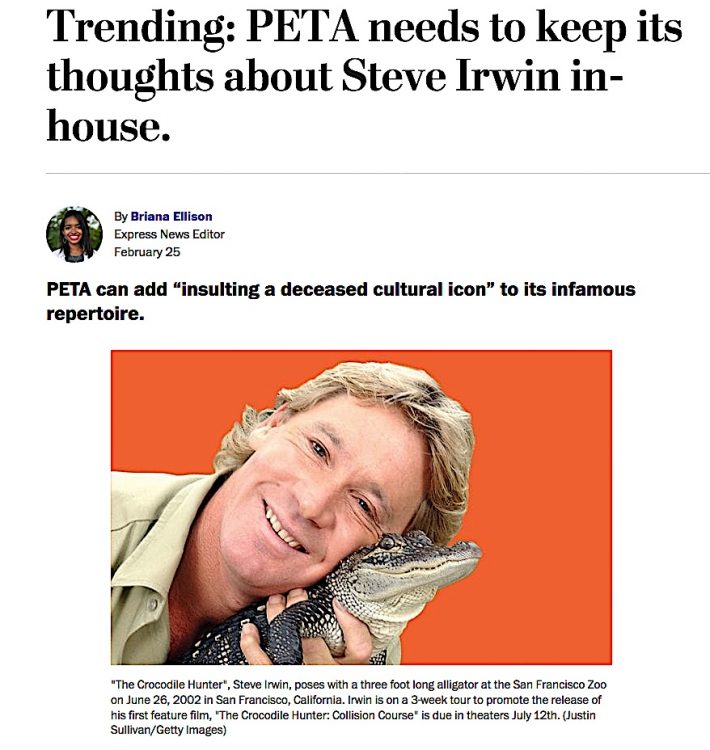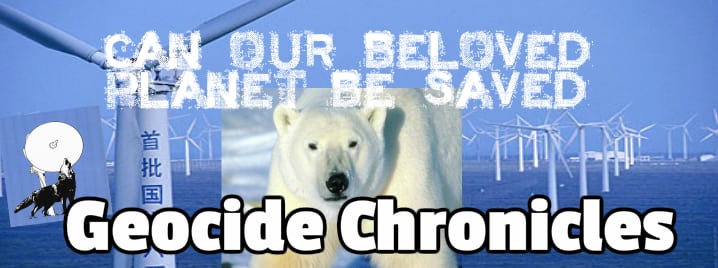The Showbiz of Conservation: PETA, Google and Steve Irwin

ABOVE: The Washington Post, a paper closely associated with the CIA and the Deep Establishment in general, and which abhors any form of radical ecological or animal rights activism has opportunistically jumped onto the bandwagon attacking PETA for supposedly desecrating the memory of a beloved "conservationist". Irwin, as author Binoy Kampmark here and others have noted, including this publication, may have been a well-intentioned lover of animals, but he was also an entrepreneur, and he undoubtedly disturbed the animals on countless occasions when it was not even remotely necessary to do so, except in the service of showmanship. (TGP screengrab from article on WaPo by Briana Ellison, 2.25.19)
![]()
by Binoy Kampmark / February 26th, 2019
[dropcap]T[/dropcap]he world of conservation has thrown up various voices of tenacity. There was Aldo Leopold, a vital figure behind establishing the first wilderness area of the United States when he convinced the Forest Service to protect some five hundred thousand acres of New Mexico’s Gila National Forest. There was Robert Marshall, the founder of The Wilderness Society. There was Rachel Carson’s Silent Spring (1962), a solidly aimed blow at the use of DDT and its environmental effects.
Then there are the savvy showmen, the exploiters few short of a scruple, and manipulators keen on lining pockets. The animal kingdom, for such types, is entertainment, much in the way that the automobile world is there for a figure such as Jeremy Clarkson. Awareness of the existence of animals – their importance, their relevance – is drummed up by means of display and provocation. The more dangerous, in a sense, the better, for here, human kind can be shown to be jousting with crocodile, sting ray and lion. Humankind can return to savage roots, confronting other species in gladiatorial encounters with film crew and an extensive promotion strategy. This is bullfighting, with a conservationist twist.
Such a figure was Steve Irwin, who made his way from Australia to the US, assisted by the solid contacts of his American wife Terri Raines, to build a name in the animal show business. He became – and here the language is instructive – the self-styled Crocodile Hunter, audacious, brash and vulgar in his animal chase. He established Australia Zoo, which sports a vision of being “the biggest and best wildlife conservation facility in the entire world, and” (note the entertainment gong here) “there is no other zoo like Australia zoo!” The emphasis here is also vital: zoos vary in history in terms of what they have done for conservation, turning species as much into museum species for spectacle as any act of preservation.
This assertion is not far-fetched; in 2004, the showman introduced his one-month old son in what was promoted as “Bob’s Croc Feeding Debut” to a crocodile at feeding time, real fun for the family. While apologising for his actions in the face of strident protest, Irwin’s rather particular view on animal advertising came through. He had, for one, been professional in keeping “a safe working distance with that crocodile when that took place”. He would also have been “a bad parent if I didn’t teach my children to be crocodile savvy because they live here – they live in crocodile territory.” Responsible, indeed.
His unique interpretation of safe working distance was again at play when he met his death on the Great Barrier Reef near Port Douglas in the course of making an installment in September 2006 for the series Ocean’s Deadliest. The ingredients were all there: identifying a species that could kill rather than anything cuddly or cute; chasing a choice sample of that species; recording, for camera, its behaviour, using whatever means necessary. In the process, the barb of a stingray pierced his heart. Marine biologists and zoologists make it clear that “they are not aggressive, reacting only when stepped on or improperly handled.” The throngs of grieving supporters were revealing about how sapping the cult of celebrity can be. Critics were few and far between.
One was fellow Australian, herself a superstar of sorts, Germaine Greer. Greer reproached Irwin for not having “a healthy respect for stingrays, which are actually commoner, and bigger, in southern waters than they are near Port Douglas.” Irwin never seemed to comprehend the vital fact “that animals needs space.” No habitat was sacred to Irwin’s celebrity predations; creatures “he brandished at the camera” were distressed. Left in such vulnerable situations, their options were limited: succumb or strike.
Irwin, whose birthday was commemorated by Google in one their “doodles” on Friday, did enough to drive the People for the Ethical Treatment of Animals (PETA) to a state of sheer consternation. Google described the doodle as a celebration of “the legendary Australian wildlife advocate & TV personality whose bravery & passion opened the eyes of millions to the wonders of wildlife.”
PETA begged to differ. Irwin, the organisation tweeted, “was killed while harassing a ray; he dangled his baby while feeding a crocodile and wrestled wild animals who were minding their own business.” The doodle sent “a dangerous, fawning message Wild animals are entitled to be left alone in their natural habitats.”
#SteveIrwin was killed while harassing a ray; he dangled his baby while feeding a crocodile & wrestled wild animals who were minding their own business. Today’s #GoogleDoodle sends a dangerous, fawning message. Wild animals are entitled to be left alone in their natural habitats. https://t.co/9JfJiBhGLw
— PETA (@peta) February 22, 2019
The organisation also reiterated that Irwin was distinctly off message in terms of conservation. “A real wildlife expert & someone who respects animals for the individuals they are leaves animals to their own business in their natural homes.”
This did not sit well in the Twattersphere and other social media outlets where outrage, not debate, characterise arguments. Unsurprisingly, Irwin’s methods are irrelevant to the persona of challenging, sporting buffoon. He entertained, and did so well; that was what counted. His cheer squad ranged across the fields of entertainment and sport, fitting given the same fold he came from. Baseball writer Dan Clark scolded PETA for not accepting the premise that Irwin had “saved the lives of countless of animals in his sanctuaries”, “loved animals and cared for them greatly.” Love, and shoddy pedagogy, are clearly variable things.
Irwin had even won over certain wildlife conservationists such as Anneka Svenska, who claimed on BBC Radio 1 Newsbeat that he “has inspired the next generation of conservationists.” Even she had to admit that “now it wouldn’t be looked at as so good to touch the animals like he used to.”
The problem with the Irwin legacy is how consequences are divorced from actions. Certain actions, be it the business model of display and torment, and the encouragement his actions supposedly did for conservationists and the cause, are blurred.
PETA might be called out for some its more shonky and inconsistent protests when it comes to the world of animal ethics, but in the scheme of things, their notes of protest were valid. Irwin was, first and foremost, a man of business, a rumbling combination of yahoo, entrepreneur and Tarzan. That business might well have involved an element of conservation, but this was ancillary to the man, to his yob image, a person made wealthy on the fate and good deal of harassing, to use PETA’s term, deadly members of the animal kingdom. For that, he paid the ultimate price.
![]()
[premium_newsticker id=”218306″]
![]() The Russian Peace Threat examines Russophobia, American Exceptionalism and other urgent topics
The Russian Peace Threat examines Russophobia, American Exceptionalism and other urgent topics


